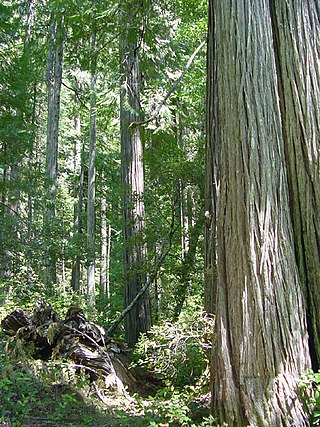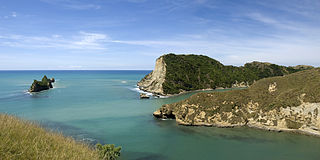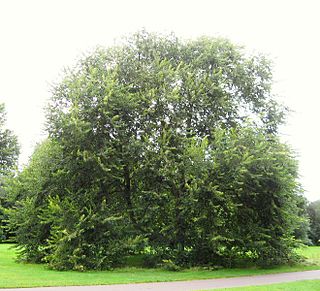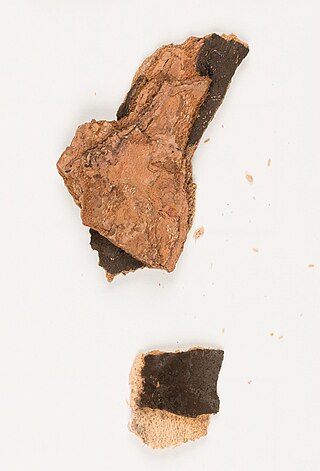Uncle Scrooge Adventures is a 1987–1997 Disney comic book series published by Gladstone Publishing under license from the Walt Disney Company. It features the adventures of Scrooge McDuck and his nephews Donald, Huey, Dewey, and Louie. It was usually distinguished from the main Uncle Scrooge title in its focus on longer, full-length stories, often in the pulp adventure style.

Chamaecyparis lawsoniana, known as Port Orford cedar or Lawson cypress, is a species of conifer in the genus Chamaecyparis, family Cupressaceae. It is native to Oregon and northwestern California, and grows from sea level up to 4,900 feet (1,500 m) in the valleys of the Klamath Mountains, often along streams.

A bark beetle is the common name for the subfamily of beetles Scolytinae. Previously, this was considered a distinct family (Scolytidae), but is now understood to be a specialized clade of the "true weevil" family (Curculionidae). Although the term "bark beetle" refers to the fact that many species feed in the inner bark (phloem) layer of trees, the subfamily also has many species with other lifestyles, including some that bore into wood, feed in fruit and seeds, or tunnel into herbaceous plants. Well-known species are members of the type genus Scolytus, namely the European elm bark beetle S. multistriatus and the large elm bark beetle S. scolytus, which like the American elm bark beetle Hylurgopinus rufipes, transmit Dutch elm disease fungi (Ophiostoma). The mountain pine beetle Dendroctonus ponderosae, southern pine beetle Dendroctonus frontalis, and their near relatives are major pests of conifer forests in North America. A similarly aggressive species in Europe is the spruce ips Ips typographus. A tiny bark beetle, the coffee berry borer, Hypothenemus hampei is a major pest on coffee plantations around the world.

A conidium, sometimes termed an asexual chlamydospore or chlamydoconidium, is an asexual, non-motile spore of a fungus. The word conidium comes from the Ancient Greek word for dust, κόνις (kónis). They are also called mitospores due to the way they are generated through the cellular process of mitosis. They are produced exogenously. The two new haploid cells are genetically identical to the haploid parent, and can develop into new organisms if conditions are favorable, and serve in biological dispersal.

Beauveria bassiana is a fungus that grows naturally in soils throughout the world and acts as a parasite on various arthropod species, causing white muscardine disease; it thus belongs to the group of entomopathogenic fungi. It is used as a biological insecticide to control a number of pests, including termites, thrips, whiteflies, aphids and various beetles. Its use in the control of bedbugs and malaria-transmitting mosquitos is under investigation.

Pourewa Island lies in Tolaga Bay, just offshore from Cook's Cove in New Zealand.
Zigzo is a Japanese rock supergroup that originally started activities in 1999 and disbanded in 2002. Each member came from a prominent band and they became very popular in the indies scene. They disbanded after their last show on March 16, 2002, reportedly due to musical differences.

The term mycangium is used in biology for special structures on the body of an animal that are adapted for the transport of symbiotic fungi. This is seen in many xylophagous insects, which apparently derive much of their nutrition from the digestion of various fungi that are growing amidst the wood fibers. In some cases, as in ambrosia beetles, the fungi are the sole food, and the excavations in the wood are simply to make a suitable microenvironment for the fungus to grow. In other cases, wood tissue is the main food, and fungi weaken the defense response from the host plant.

Ulmus villosa, the cherry-bark elm or Marn elm, is one of the more distinctive Asiatic elms, and a species capable of remarkable longevity. It is endemic to the valleys of the Kashmir at altitudes of 1,200–2,500 metres but has become increasingly rare owing to its popularity as cattle fodder. Mature trees are now largely restricted to temples and shrines where they are treated as sacred. Some of these trees are believed to be over 800 years old.
Herman Diedrich Spöring Jr. (1733–1771) was a Finnish explorer, draughtsman, botanist and a naturalist.

Blue River is an album by folk rock musician Eric Andersen, released in 1972. The album was reissued in 1999 by Columbia Legacy with two extra tracks.

The Broadway is a performance venue in Barking town centre. The building was previously a facility known as Barking Assembly Hall, forming part of Barking Town Hall.

Samantha Jane Barks is a Manx actress and singer who rose to fame after placing third in the BBC talent show-themed television series I'd Do Anything in 2008. She has released three studio albums: Looking in Your Eyes (2007), Samantha Barks (2016), and Into the Unknown (2021), and made her film debut as Éponine in the Tom Hooper-directed Les Misérables in 2012. Her performance in the film won her the Empire Award for Best Female Newcomer and a shared National Board of Review Award with the film's cast.

Psilocybe stuntzii, also known as Stuntz's blue legs and blue ringers it is a psilocybin mushroom of the family Hymenogastraceae, having psilocybin and psilocin as main active compounds.

Psilocybe cyanofibrillosa, also known as rhododendron psilocybe and blue-haired psilocybe, is a psilocybin mushroom of the family Hymenogastraceae having psilocybin and psilocin as main active compounds. First documented in 1980 in the Pacific Northwest, it is relatively uncommon and can be distinguished from other closely related species by its smaller spores and forking cheilocystidia. Psilocybe cyanescens also has forking cheilocystidia, but less often than Psilocybe cyanofibrillosa. Psilocybe cyanofibrillosa is also distinguished from Psilocybe cyanescens by an absence of pleurocystidia. The name of this species refers to the fibrils on the Stipe (mycology) that turn bluish in age, or when handled.

Fuligo septica is a species of slime mold, and a member of the class Myxomycetes. It is commonly known as scrambled egg slime, or flowers of tan because of its peculiar yellowish appearance. It is also known as dog vomit slime mold or Jasmine mold and is relatively common with a worldwide distribution, often being found on bark mulch in urban areas after heavy rain or excessive watering. Their spores are produced on or in aerial sporangia and are spread by wind.

Myxogastria/Myxogastrea or Myxomycetes (ICN), is a class of slime molds that contains 5 orders, 14 families, 62 genera, and 888 species. They are colloquially known as the plasmodial or acellular slime moulds.

Dalma Wildlife Sanctuary is a wildlife sanctuary located 10 km (6.2 mi) from the city of Jamshedpur in the state of Jharkhand. Inaugurated in 1975 it contains a significant population of the Indian elephant.

Fomes fomentarius is a species of fungal plant pathogen found in Europe, Asia, Africa and North America. The species produces very large polypore fruit bodies which are shaped like a horse's hoof and vary in colour from a silvery grey to almost black, though they are normally brown. It grows on the side of various species of tree, which it infects through broken bark, causing rot. The species typically continues to live on trees long after they have died, changing from a parasite to a decomposer.

Cryptostroma corticale is a species of fungus that causes sooty bark disease of maples, particularly sycamore. The spores grow profusely under the bark of affected trees or stacked logs. The fungus causes disease and death in trees, and the spores are allergenic and cause a debilitating pneumonitis in humans.

















